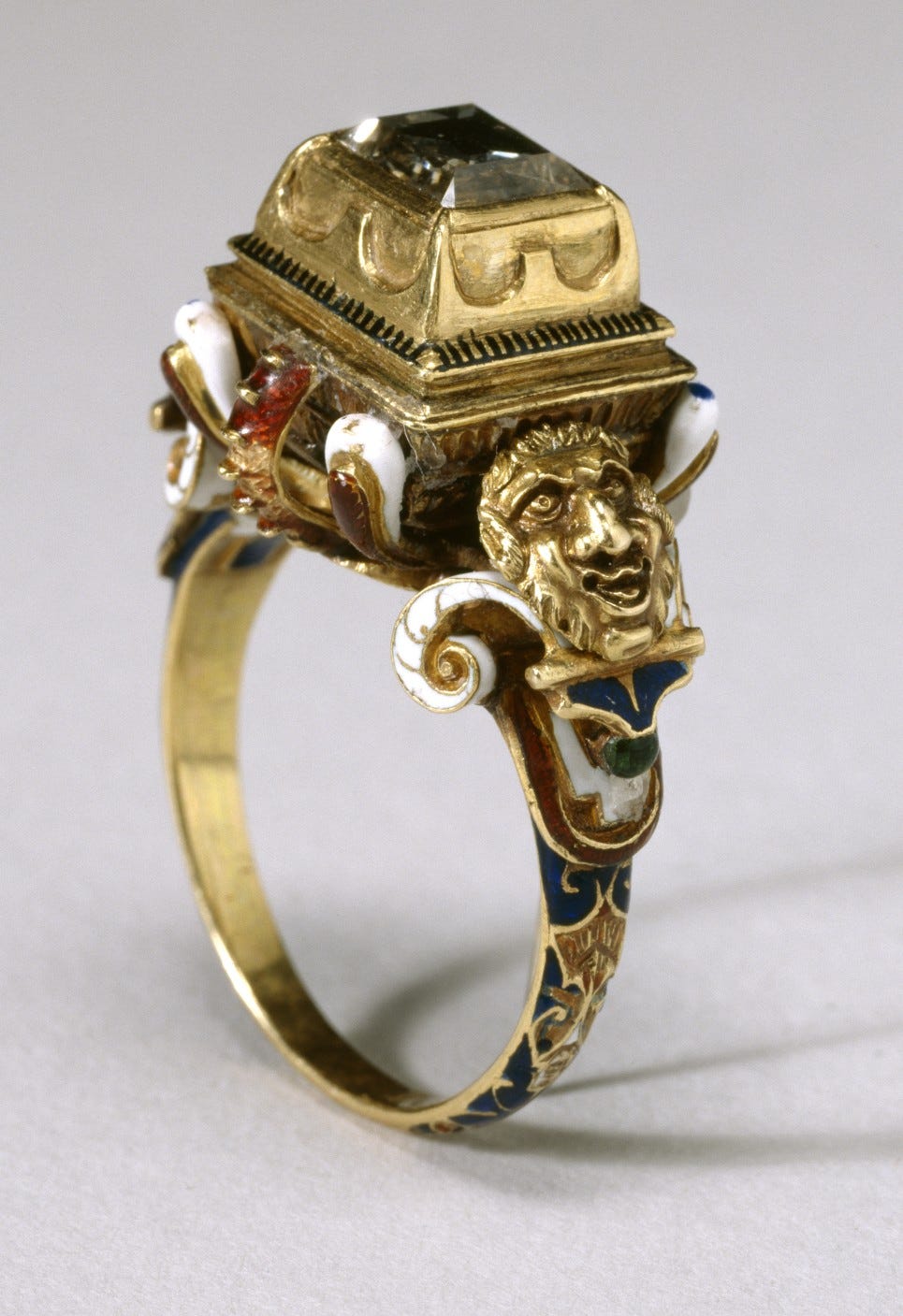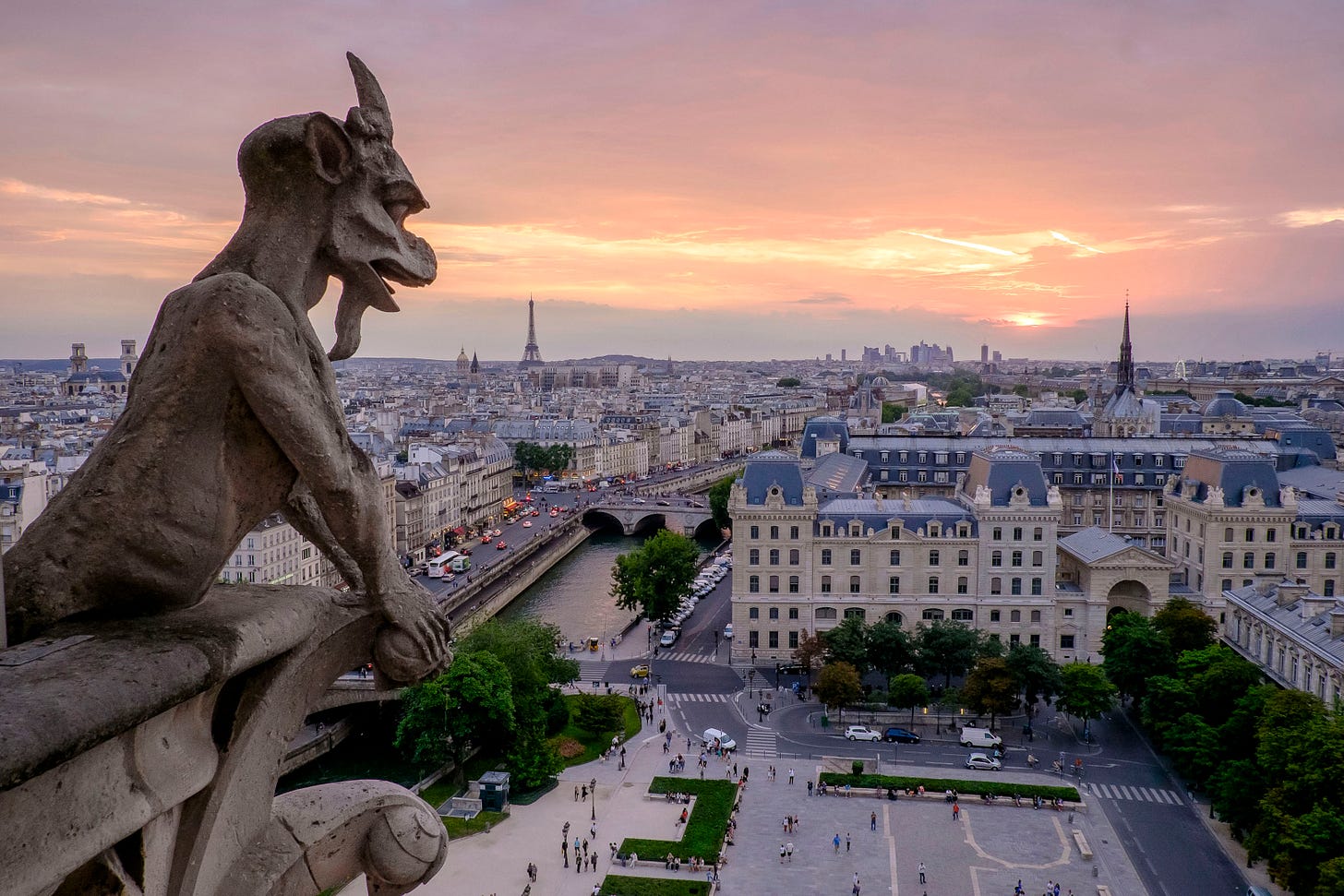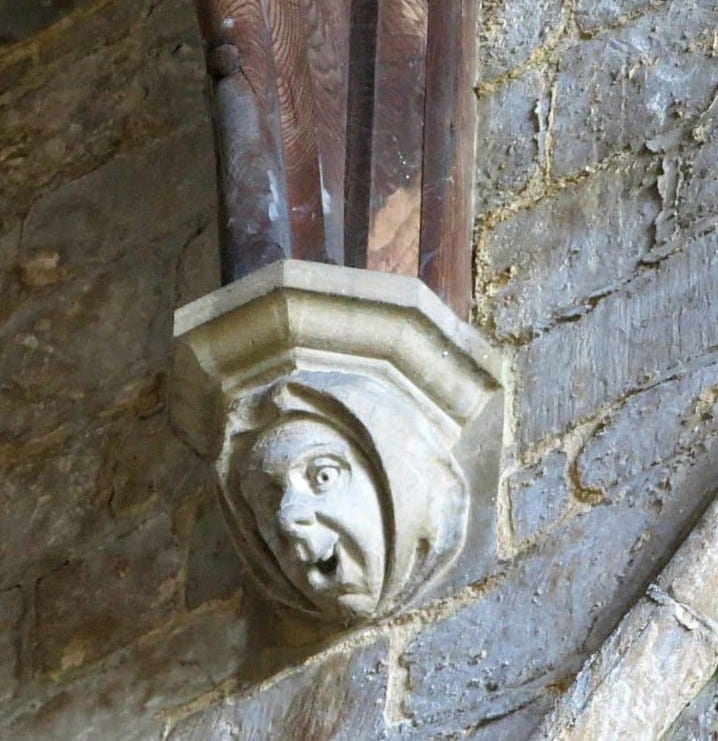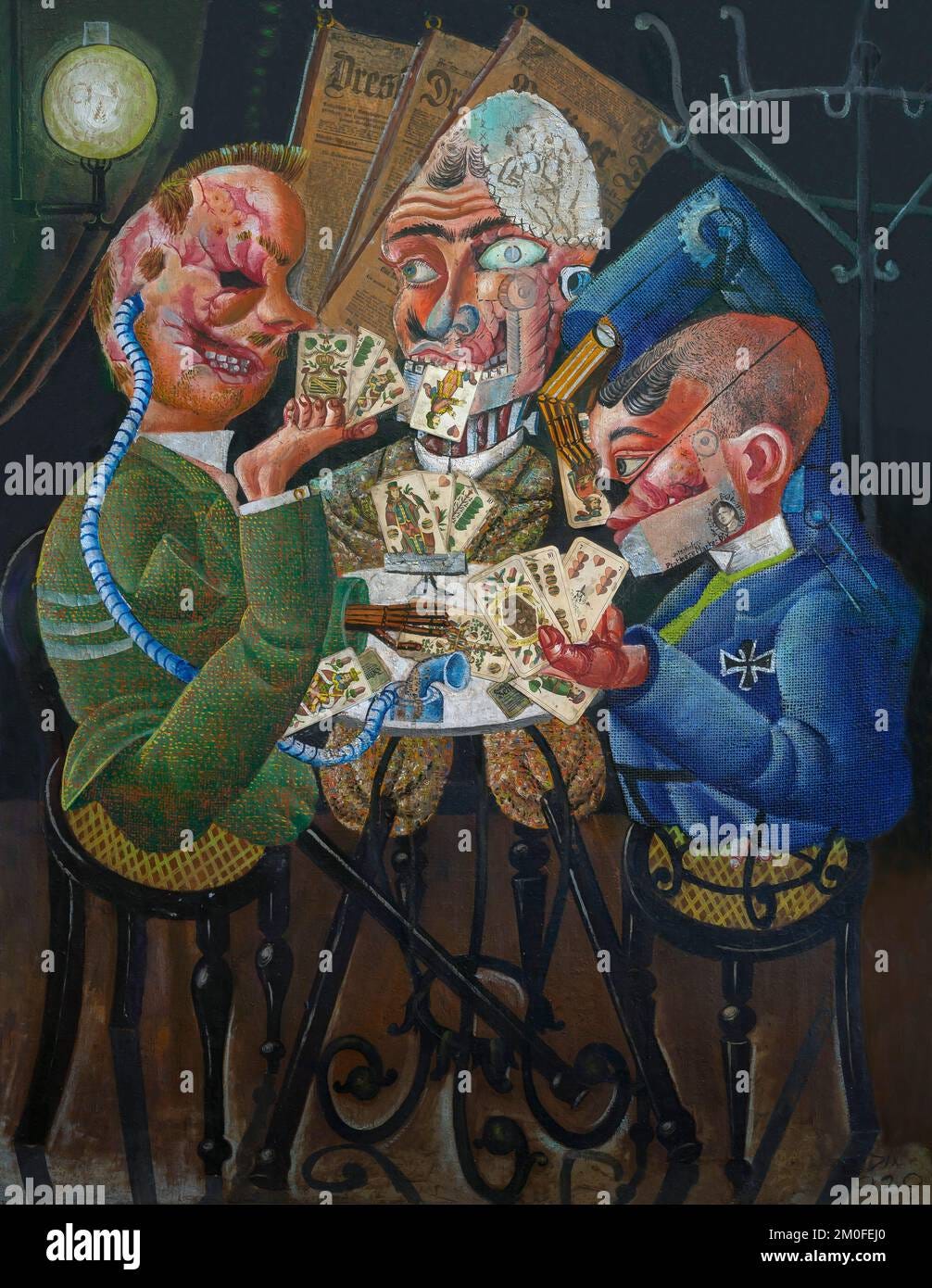Grotesques: The Duality of Beast and Beauty
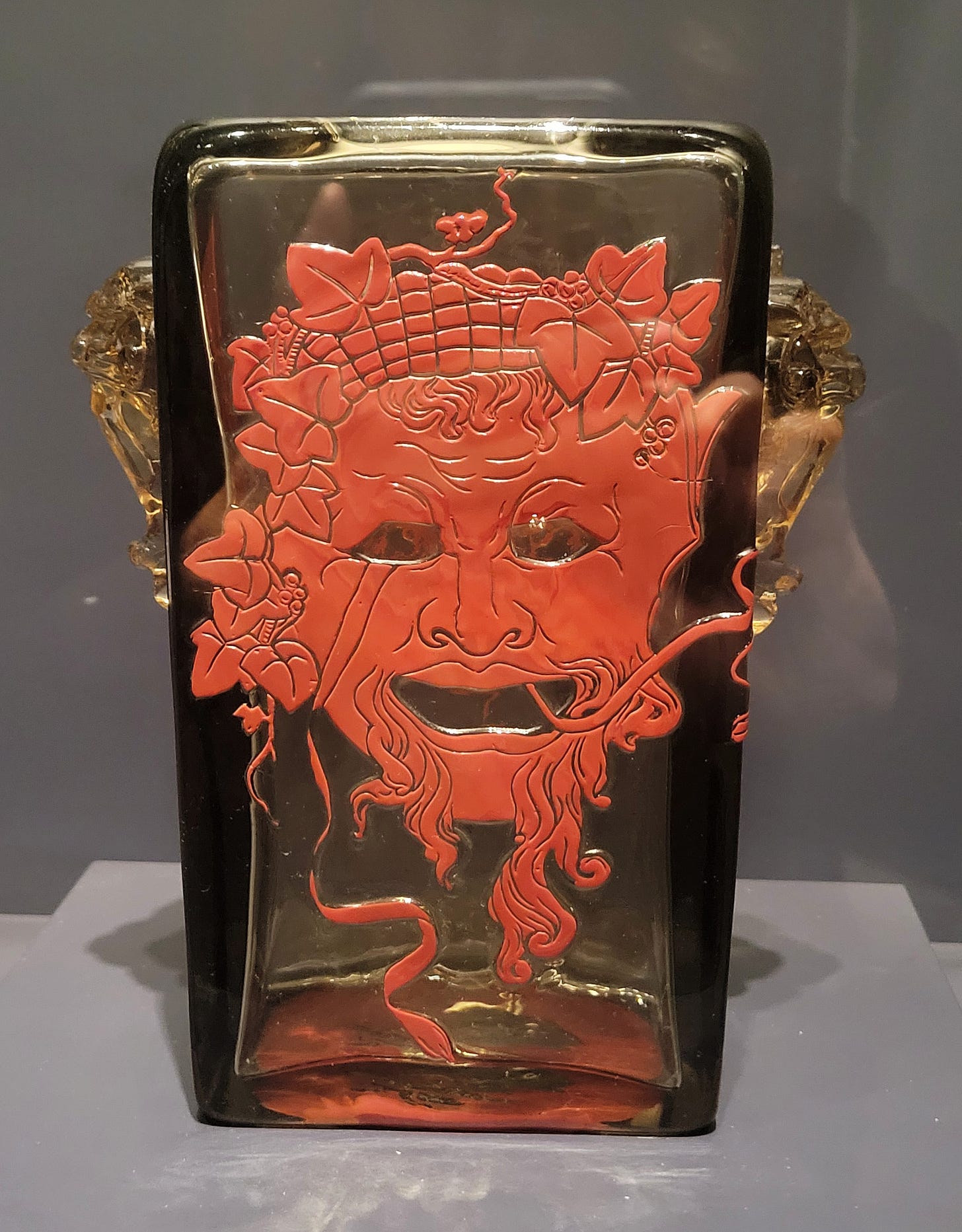
Upon entering the Walters Art Museum in Baltimore, I was drawn to a striking object on display. It was undoubtedly a beautifully crafted glass vase. But it was the fiery central figure within that captivated me. As a teacher of design, I recognized this image in its artistic historical context- “Green Man.” Simply stated, Green Man is the embodiment of humanity with the natural world… with leaves sprouting from its head.
But let’s take a closer look. And…like me…you will see something more sinister in this face, which doesn’t project renewal- as the foliate on this figure would imply. So I dug deeper to understand why this French artist, Eugène Rousseau, would have fashioned the face this way. And all was revealed- Green Man could also be a Grotesques. (Such fun words in art to describe the symbolic nature of things.) Let me note here that the color red used in this vase, instead of green, hints at what this artist was trying to convey about this piece- a fusion of the European Green Man concept with Japanese demon images from the Edo Period.
But let’s address whether these are actually beastly or beautiful. I contend they are both. I described the facial expression on the glass vase above as being sinister. Green Man figures are known to sometimes have a hideous, unsettling quality. But Grotesques are also associated with banishing evil. So gazing upon one can act as a reminder of warding against this evil.
Grotesques, however, can have many faces…as we will explore a bit later.
Therein lies the intrigue and beauty to grotesques… I liken these to “memento mori” or “remember you must die” objects created in the 16th century, and onward, as being somewhat foreboding in design… to rising above its design to address a greater meaning in life. (“Memento mori” will be the subject of a future curated newsletter.) Like Memento Mori objects, the same can be said of Grotesques as there is so much more to explain their raison d’etre…
~~~~~~~~~~~~~~~~~~~~~~~~~~~~~~~~~~~
The Grotesques in art is a wonderfully fascinating subject…
When we think of something as being grotesque, we think of it as being repulsive or distorted. But it is also defined as possibly being comical. In art, a Grotesques is defined this way- “a style of decorative art characterized by fanciful or fantastic human and animal forms often interwoven with foliage or similar figures that may distort the natural into absurdity, ugliness, or caricature.” So not only are these mesmerizing to look at, but Grotesques have multi-layered meanings.
We must first begin with, and credit, the ancients for introducing us to these strangely curious and menacing figures in art.
Grotesques in ancient times were arrangements of ornamental arabesques (I describe “arabesques” in my Substack- Writing ‘Contains’ Beauty) with interlaced garlands and beastly figures/ bizarre human faces. This form of decorating the Grotesques continued into the16th Century Renaissance period.
The word grotesques, as it applies to works of art, was actually first given to paintings found in the underground ruins of Nero's Domus Aurea (Golden House) in Rome in 16th century. These ruins, nicknamed “caves” (grotte in Italian), were decorated with frescos representing strange motifs- half-human, half-animal figures and ornamental foliage- inspired by Ovid’s Metamorphoses.
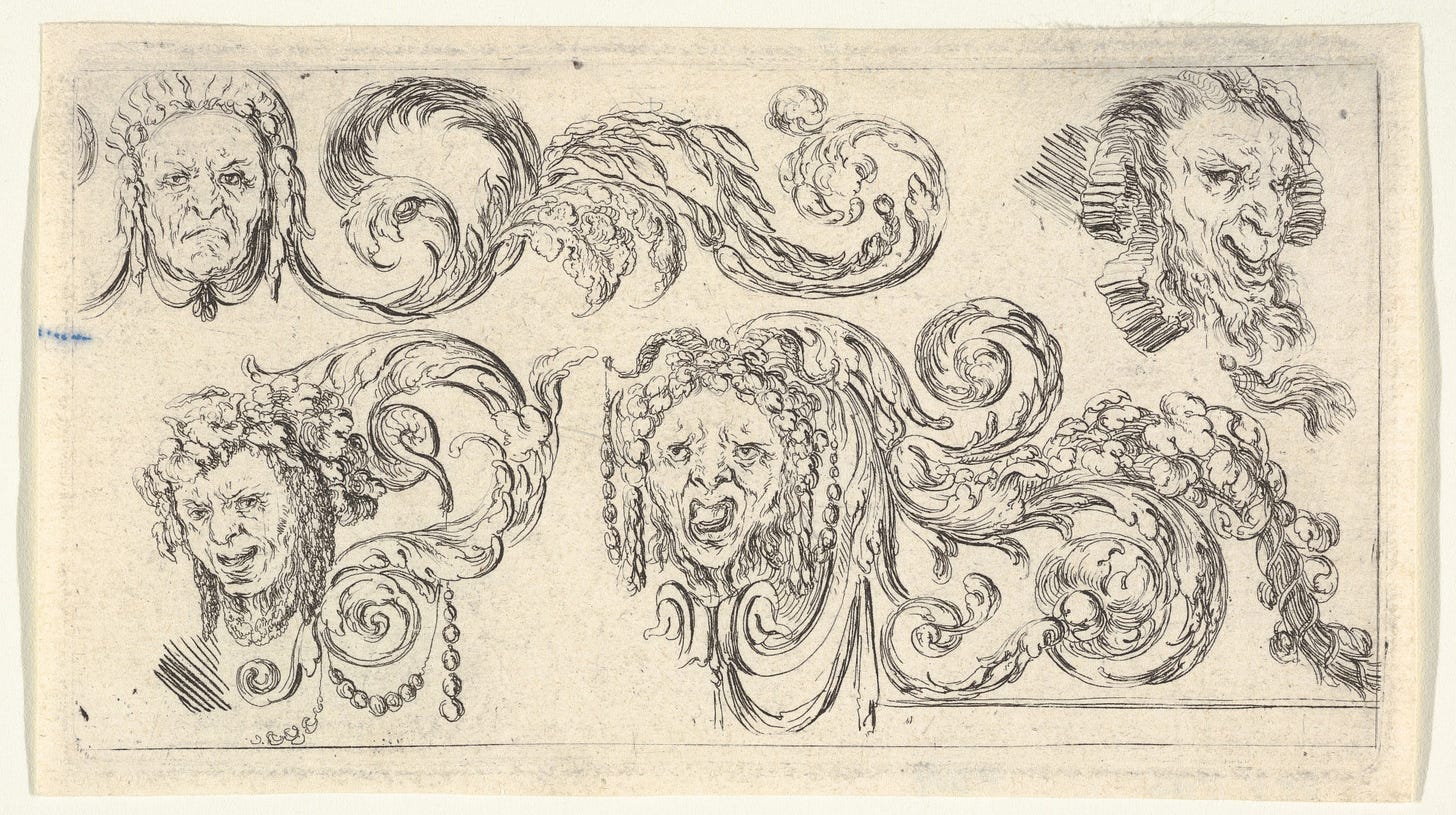
The article, “The Grotesque: Mischief and Wonder in Renaissance Art”, noted in the treatise De Architectura, that Vitruvius (25 BC) described the artists who created these paintings as having “depraved taste… monsters are now painted in frescoes rather than reliable images…”
Renaissance artists chose to depict grotesques as being fantastical and frightening beings. The intent of which was to explore the darker side of human nature and the subconscious.
In the image below, this painting, along with others, was discovered in the16th century behind a hidden staircase at the Palazzo Vecchio in Florence- the former residence of Duke Cosimo I de’ Medici and his wife Eleonora of Toledo. This is another prime example of how Renaissance artists imitated Grotesques frescoe paintings from the ancients.
The ring pictured below is a stunning example of a grotesques jewel in the Renaissance Period. According to The Walters Art Gallery that house this elaborate ring, “The ring is lavishly covered with multicolor enameling extending on to the hoop. On each openwork shoulder, a large, grotesque mask is flanked by two enameled volutes.”
This ornamental grotesques concept in art was far-reaching to many countries as well- including France, Italy, Spain, Germany, the United Kingdom and Japan.
Below is an example of an ivory exaggerated lion figure netsuke from Japan in the Edo period, 17th -19th C.
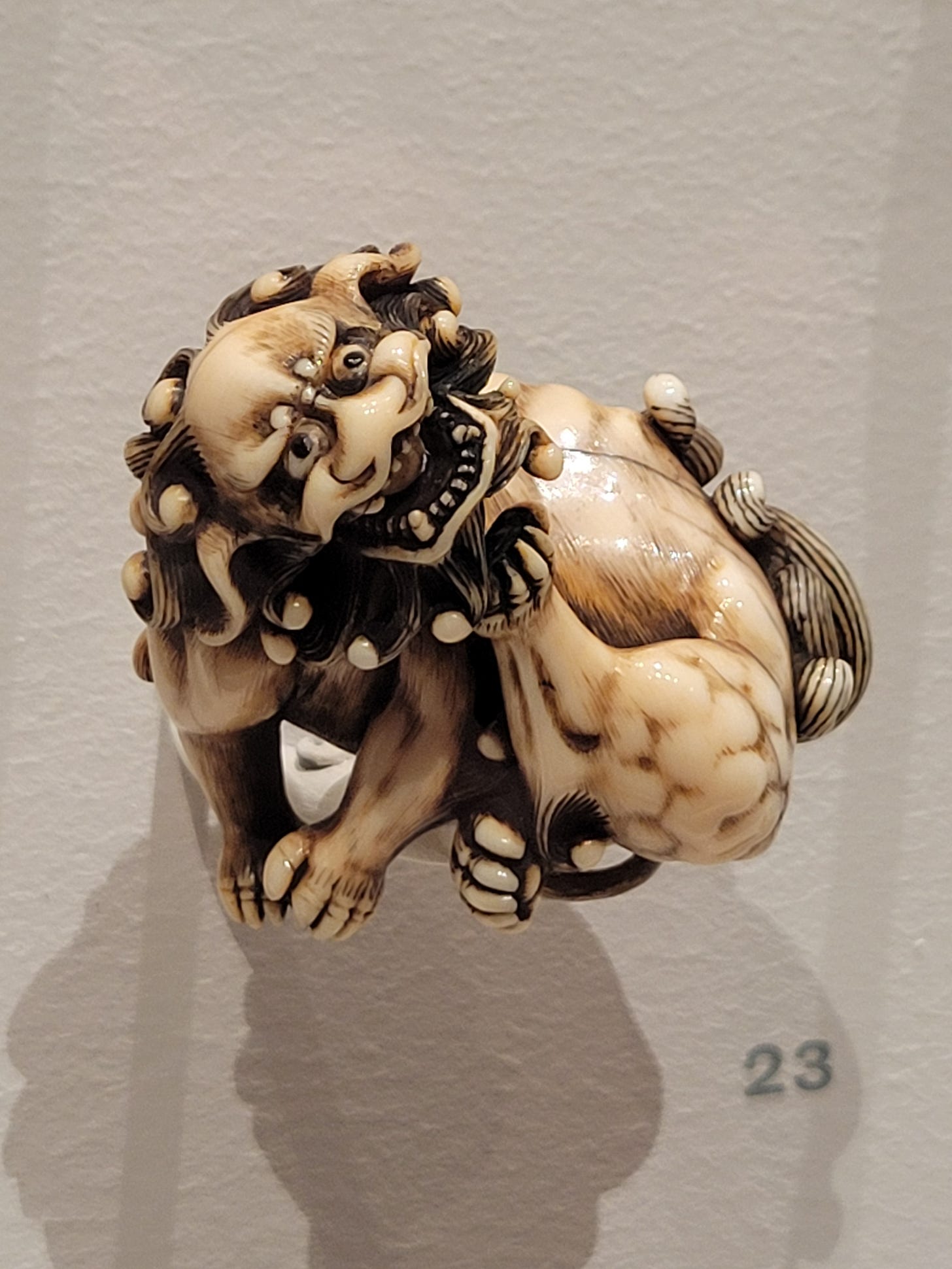
This netsuke clearly demonstrates that in Japan supernatural beastly creatures were used as a significant motif in Japanese netsukes. Netsukes are Japanese miniature sculptures, usually sculpted in ivory (but also boxwood) which reflected ancient Japanese folklore and supernatural beliefs. Initially utilitarian in function, they later evolved into artistic expressions, with grotesques becoming a favorite figure (very much like the image pictured above.)
Christies auction explained the complexity and charm of netsukes this way- “As netsuke evolved so did the design vocabulary, encompassing mythological creatures, religious subjects, zodiacal animals, kabuki actors or literary heroes. Netsuke could even be subversive — erotic in nature, or used as social satire. Their designs often mirrored broader trends in Japanese art.” I think this is why I took many pictures of netsukes and inros at the Boston Museum of Fine Art as their collection is vast, varied, so intricately designed, and wondrous works of art. This unique form of Japanese artistry is a personal favorite of mine.
As this story continues, you will see these designs repeated in many grotesques artforms.
~~~~~~~~~~~~~~~~~~~~~~~~~~~~~~~~~
A telling feature of the Grotesque- the mouth- and Gargoyles…
In all the images pictured above- the Grotesques Mask design glass vase (first featured), the Palazzo Vecchio painting, the Renaissance ring, and the Japanese netsuke, there is something particularly noteworthy… the mouth is wide open.
There are different theories as to why this is so…
One school of thought is that the representation of the mouth, as a central feature of the Grotesques, is associated with being voracious and salacious- in other words, the darker side of human nature.
But the open mouth is also directly linked to the creation of Gargoyles. Who among us has not actually seen a gargoyle or at least seen a picture of one perched high atop a cathedral or church or public building?
Acting as reminders of the separation between the earthly and the divine, stone carvers had great fun sculpting gargoyles into delightfully monstrous or playful carvings.
As such, many gargoyles were considered grotesques with one major difference- grotesques were ornamental only with no utilitarian feature, unlike gargoyles. But both gargoyles and grotesques were intended to scare and protect…and sometimes make us laugh.
And, gargoyles were always carved with big wide-open mouths! This was for functional reasons as they were used as a spout for drainage - carrying the water away from the stones and the mortar of churches, cathedrals and castles to protect it from erosion.
But gargoyles have ornamental value also….
In the Middle Ages “Gothic” period into the 18th-19th century “Neo-Gothic” period (and still today), gargoyles are considered ornamental architectural accoutrements! They’re also considered 'guardians' of religious buildings as their wide open mouths are seen as a great symbolizer of devouring evil.
As noted in This Old House article, “History of Grotesques and Gargoyles”, “Historically, many gargoyles have their mouths agape, some with their tongues protruding, symbolizing a devouring giant—a force beyond our world that we must pay homage to. However, 19th and 20th century carvers often sculpted their work from pictures in pattern books, and didn’t really know exactly what the original artist’s intentions were.”
Beguiling Gargoyles….
I must begin with one of the most famous structures- Notre Dame Cathedral in Paris. Its gargoyles are many, magnificent in detail, and feature some of the most wondrous examples of medieval style gargoyles and chimeras (in Greek mythology- a fire-breathing female monster with a lion's head, a goat's body, and a serpent's tail) in French Gothic architecture. It must be noted that the majority of the gargoyles on Notre Dame were added during a 19th century restoration by architect Eugène Viollet-le Duc. When a devastating fire erupted on Notre Dame on April 19, 2019, this magnificent cathedral, and its gargoyles, went under a major restoration to restore it to its original glory.
Other photos of gargoyles….

~~~~~~~~~~~~~~~~~~~~~~~~~~~~~~~~~~
The many faces of Grotesques…
From being highly decorative and beastly, Grotesques evolved and took on many forms- even more bizarre and humorous in design over the centuries. I hope I did justice in capturing the spirit of this evolution!
Bizarre figures, mocking human behavior or societal norms…
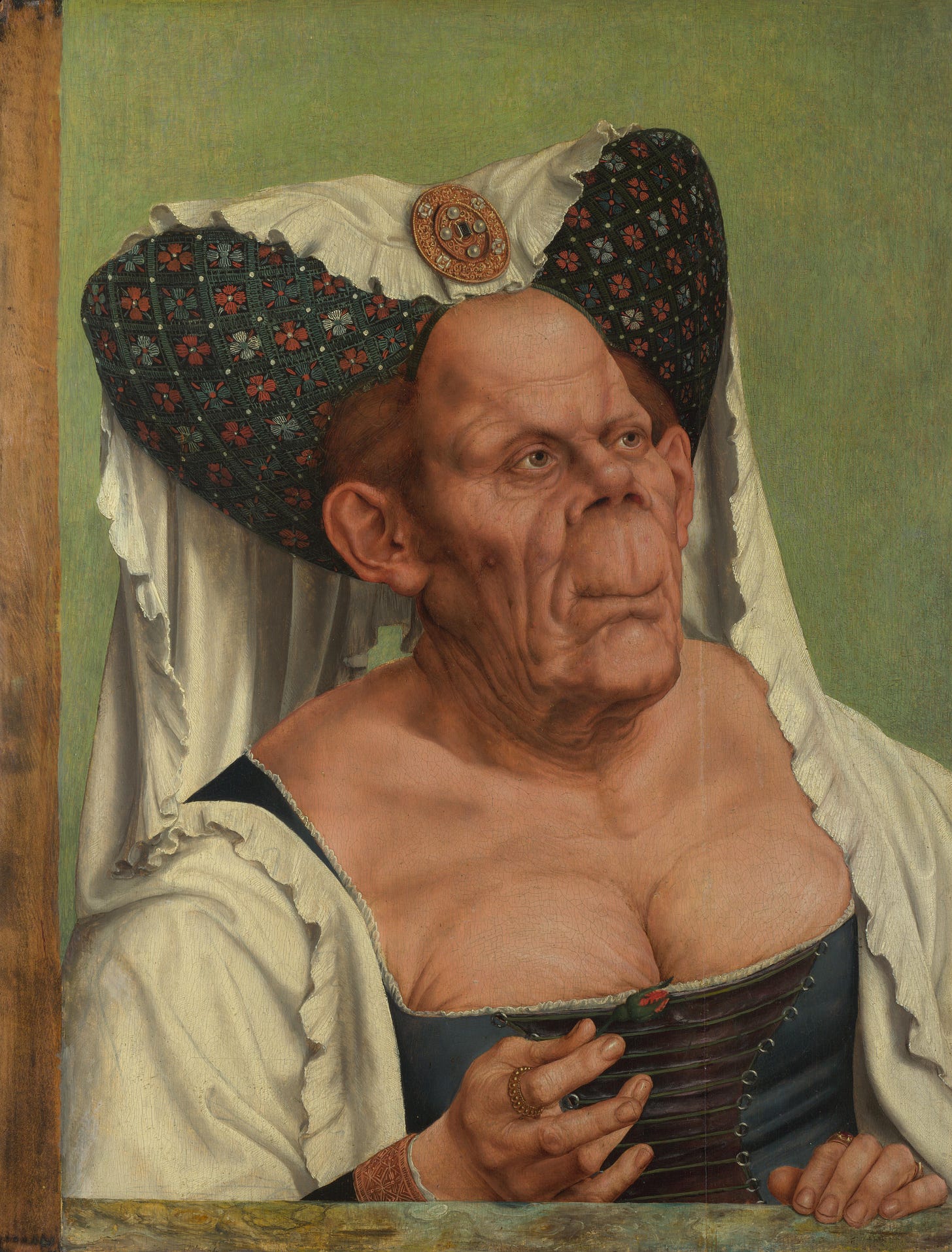
Social Commentary figures…

Humorous figures or comical, exaggerated versions of ordinary activities…
In discussing grotesques, I must mention the German artist Ott Dix (1891-1969.) I think you can discern, from the two images directly above, that Dix was the quintessential artist of the Grotesques style, particularly after World War I. Figures were reflective of the hideous effects of war and were, as in the case of the first image, unnerving…or, as in the case of the second image, exaggerated and absurd. But one thing is for certain-you will have a visceral reaction when you view his paintings. Like them or hate them- they clearly made a social commentary on society, politics, war and its aftermath. Dix’s works of art were particularly raw and unforgiving.
Theatrical Satire…
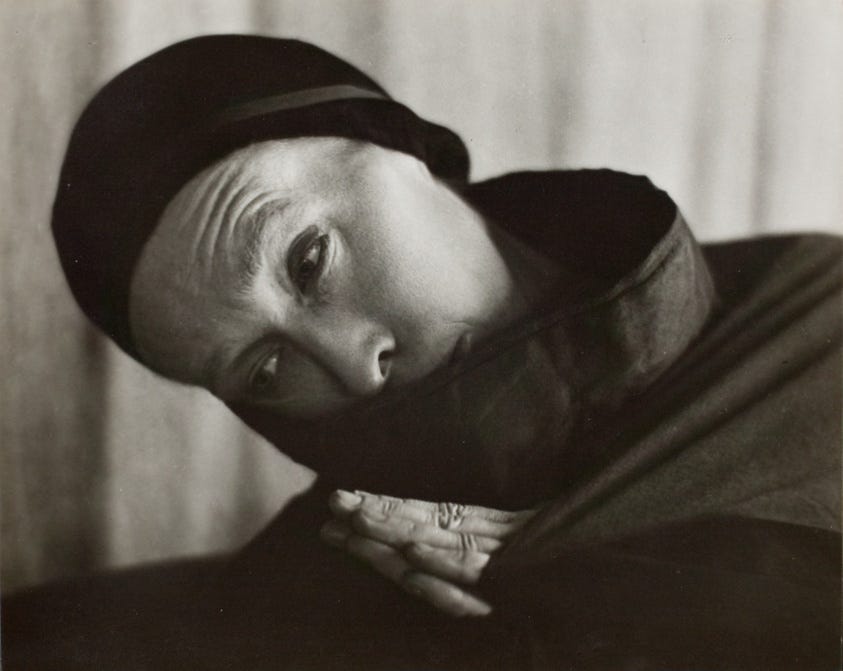
Film Focus… (I had to include this- just for the fun of it!)
Speaking of gargoyles… behold the demon Zuul gargoyle in the 1984 Ghostbuster film.
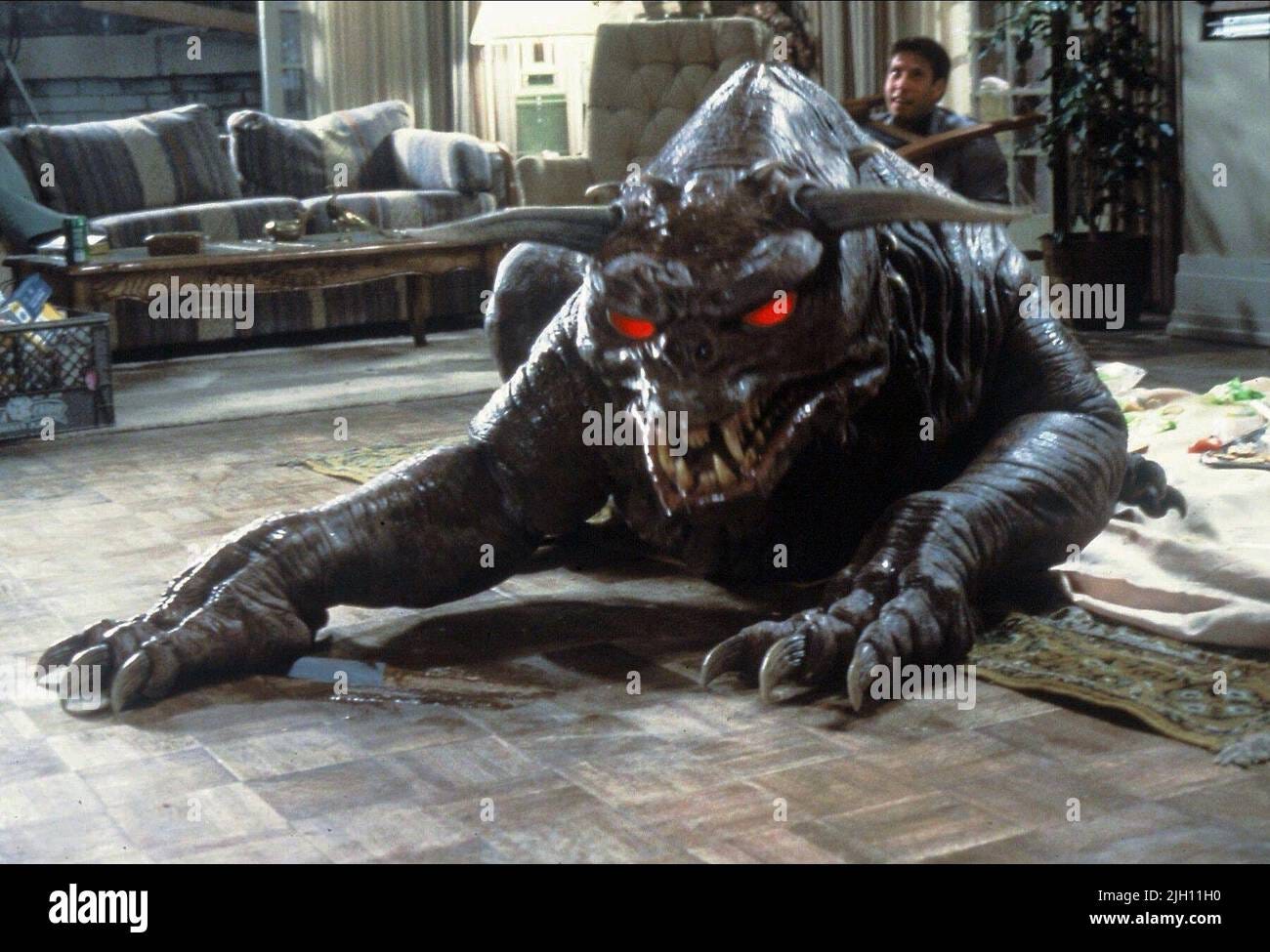
Grotesques and their relevance in Contemporary art…
I must mention some contemporary artists whose imagery is haunting and unsettling; drawing from Grotesques historical traditions and contemporary concerns. These include Albert Tucker, Cindy Sherman, Mona Hatoum, Dimitry Parkin, Marianna Simnett, Junji Ito, Keith Thompson, Wayne Barlow, Jocelyn Hobbie and Ralph Steadman. Their art examines the notion of identity in our society, marginalized bodies, political and societal turmoil, mental anxiety, and even mortality. But there are some that go beyond the unimaginable and are just too disturbing to even show here…e.g. “Why Contemporary Women Artists Are Obsessed with the Grotesque” on artsy.net.
Illustrations by contemporary artists, Ralph Steadman and Junji Ito, featured below capture the Grotesques imagery and spirit of what I have been discussing here.
Ralph Steadman is a British illustrator and collaborator with American author Hunter S. Thomas. Known for his political and societal satirical illustrations; the image below is from Fahrenheit 451, a book in our personal collection.

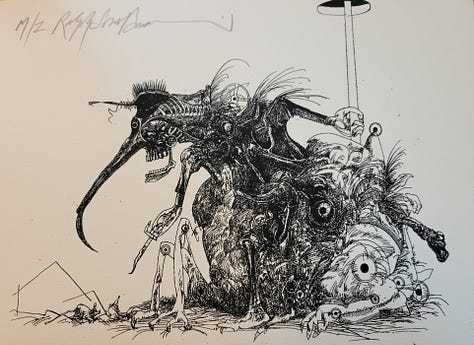
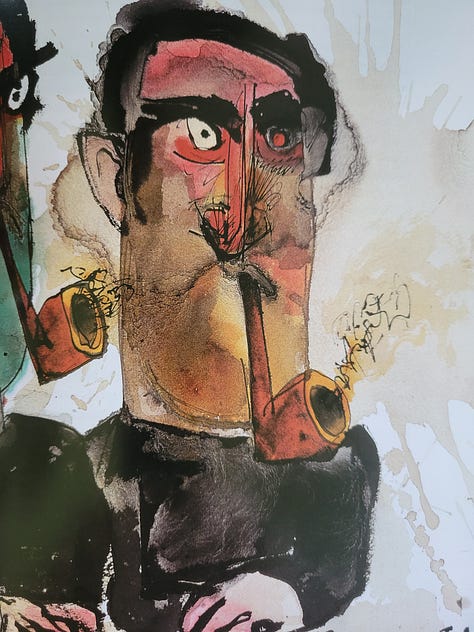
Junji Ito is a Japanese horror manga artist
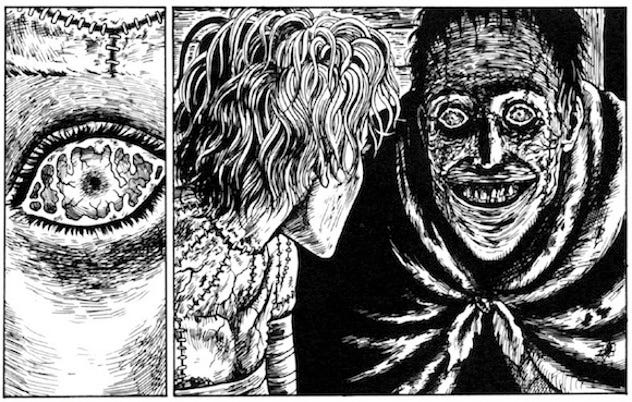
I welcome comments as to other artists working in this realm as I know there are so many more, given the complex and unsettling world we live in today…
Fun Facts:
Christopher Rader, a 13-year-old kid from Nebraska, designed the Darth Vader pictured below- envisioning the Star Wars villain as a modern incarnation of supreme evil. Sculpted by Jay Hall Carpenter and carved by Patrick J. Plunkett, this dark-sided Anakin gargoyle is on the Washington National Cathedral, of course wearing his iconic helmet!
Walter S. Arnold, along Jay Hall Carpenter, created The Crooked Politician gargoyle, featured on the right, which is also on the Washington National Cathedral.
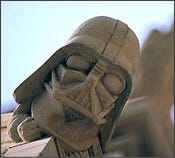
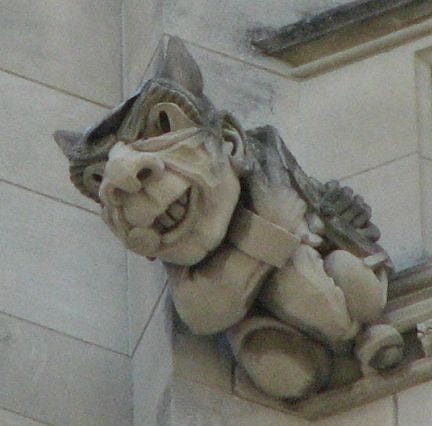
For more on these and other stories see: Pop Culture Gargoyles Hidden in Gothic Architecture, Atlas Obscura.
A final word about Grotesques in art and architecture…
From the playful to the comical to the macabre to the disturbing…it is apparent that Grotesques have remained in our consciousness as they undoubtedly continue to haunt or delight us.
Perhaps it is the darker side of life and human nature portrayed in many grotesques that fascinates us. Perhaps they simply amuse us.
Or perhaps, as Canadian sculptor, David Altmejd, said…
“For me the grotesque is necessary to understand beauty.”
Enjoy reading and please subscribe to my free newsletter below. Comments are always welcome!
Thank you for reading Donna’s Substack- The Object Is the Story! Subscribe below for free to receive new posts and support her work.





